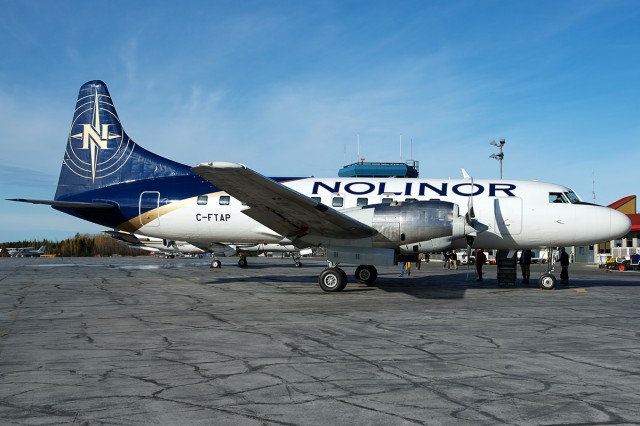
One of Nolinor’s Convair 580s on the ramp at Rouyn-Naranda – Photo: Bernie Leighton | AirlineReporter.com
April 1956 represented a different era in aviation. Local service airlines were popular, fares were regulated, and people still dressed-up to fly. It was also when the three hundred thirty-fourth Convair 440 rolled off the assembly line to start service with Canadian regional airline Time Air.
The Convair 440 was built to American Airlines’ specifications to serve as a pressurized DC-3 replacement. It was equipped with Pratt & Whitney Double Wasp engines and three-bladed propellers, weather radar and a few other features that distinguished it from the original 240s.
After entering service, the Allison Engine Company (now a division of Rolls Royce) devised an offering to re-engine Convair 440s with T56 turbines (the same engine as the Lockheed C-130, P-3 Orion, and Electra II). This added thousands more shaft horsepower, and allowed for not only greater range, but a higher cruising altitude. The conversions were done by Pacific Airmotive and could be done in as short as sixty days.
Time Air sold line number 334 to Canair Cargo, who proceeded to park it in 1998. Nolinor Aviation purchased the airframe and converted it back to passenger use later that year. Throughout the years, the registration has remained the same; C-FTAP. Recently, I had the opportunity to fly on this classic bird.
To fly on C-FTAP, I had to travel from downtown Montreal to Canada’s largest public works failure: Montreal Mirabel International Airport (YMX). Whilst it may now be home to the manufacturing base for Bombardier, it was supposed to be the premier airport of eastern Canada. Mirabel was designed and built at a time when traffic into Montreal was growing at an alarming pace. Dorval (now P.E. Trudeau) was going to be over capacity within ten years. Something had to be done. The original plan was to construct Montreal’s new airport in a location that would allow it to also serve Ottawa. Quebec politics, however, made sure that such an amazing airport would never be close to an English-speaking province, so construction went ahead at a site that was viewed as a compromise.
Located 35 miles from the city center, it never achieved any appropriate road, highway, or rail links and as such, withered on the vine. Oddly, YMX shares it’s runway and taxiway configuration with another airport of the era… ZKPY (Pyongyang, North Korea). From the air, thanks to the lack of traffic, it is strangely reminiscent. On its opening in 1975, all international flights were immediately transferred there. Domestic and trans-border flying, however, continued out of the more convenient Trudeau airport. The fact that one-stop flights often cost drastically less than their one-stop competitors (due to the insane cost of a taxi to Mirabel) sealed the airport’s fate before other flying could be moved.
Today, other than Bombardier, Mirabel is home only to Nolinor’s hangar and passenger operations center, a few MROs, and all of Montreal’s overnight freight capacity. Norlinor’s Mirabel facility doesn’t look out of place in any Canadian public works project circa its date of construction. In some ways, it resembled my old high school in Edmonton, Canada. The exterior is where the differences began and end.
It is clear that Nolinor has spent a lot of money and effort to produce the nicest lounge I have ever seen. They even have an exercise facility called the “Nolingym” and 737-200 and Convair-based art abounds. I am glad that their executives had the courage to make the facility about “embracing the plane.”
Due to some fairly stringent Transport Canada restrictions, instead of being led through the hangar and onto the ramp, we had to go back downstairs and board a branded bus, which would then drive us the roughly 300 feet to C-FTAB.
Maybe it’s the proportions of the engines in relation to the fuselage, but the Convair 580 looks much larger than it actually is. It may be thirty three feet shorter than a Q400, but it doesn’t feel like it.
Upon boarding, I sat myself down to have a good engine/prop view and much to my dismay the window glass (now 57 years old) had begun to distort! It did not have a huge effect on any photography – but it was a tense few seconds.
Nolinor’s Convairs have the classic “hat-rack” style overhead bins and extremely ample seat-pitch. I was never able to get a definite answer, but they estimated 34 inches.
To start a CV-580 efficiently, it’s wise to use a ground-start cart. Ours was connected and after it generated a high-amperage current, the number-two T56 engine began to spool up.
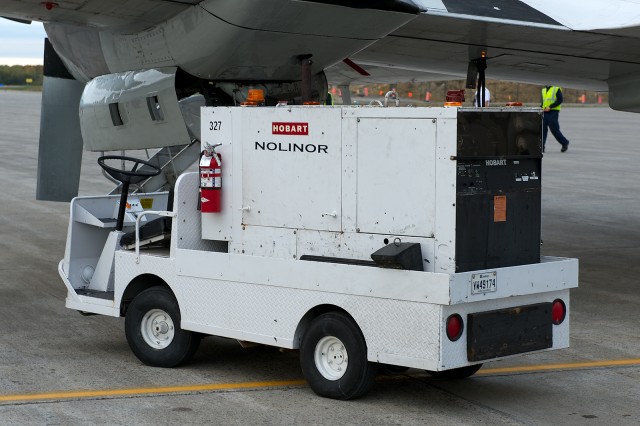
The ground-start cart used to provide current to start a Corvair 580 – Photo: Bernie Leighton | AirlineReporter.com
Those of you who have flown on any T56-engined aircraft will understand that they are not quiet (thankfully, for us AvGeeks). It’s completely different in sound than similarly-sized propliners of the era, for example the IL-18. It is somehow deeper and less shrill, something more akin to a chainsaw motor.
Both engines going, surprisingly, did not generate much cabin vibration. I would actually attest that it was a smoother taxi than I’ve had on any of the Dash-8 family. Perhaps it has something to do with the construction of the wingbox and its low-wing design? Either way, it is a bizarrely-comfortable aircraft.
Takeoff was properly loud! I am sure that if the conversion process to become a 580 had not included additional sound insulation, it might have been the one of the loudest things I have ever flown on. Either way, I believe that with prolonged exposure, it could potentially cause hearing damage. In other words, I have to recommend it on that alone — the louder, the better for me.
Our route to Rouyn-Naranda airport in northern Quebec took us up to 18,000 feet. Much to my happiness, the 20% chance of clear skies had won. It was going to be a calm, sunny day in rural Quebec after all.
Shortly after we reached cruising altitude and the dutiful Nolinor flight crew was able to herd the group of aviation enthusiasts back to their seats, service began. By service, I don’t mean a bag of crisps. I mean a nice fruit plate, branded water bottles, and Nolinor signature candy. Coffee was also offered, in appropriately-branded mugs.
Nolinor caters primarily to the resource industry, who expect a very high standard of service. To say the least, Nolinor delivers.
The 580 cabin, in its 2-2 configuration is spacious. The aisles are not constricted like its modern turbine cousins. If the 580 was in service with scheduled airlines today, I imagine they’d try and make it 3-2. It could be done considering the aircraft has the appropriate number of exits. I discovered just how wide the aisles were whilst everyone was moving around the cabin. There was never a need to step into a seat row to let someone pass. For reasons I am still unclear on, there is a door that separates the passenger cabin from the L1 door and the flight deck. There are no crew seats there, so I am still trying to figure out its purpose. It is not as if we’d have been allowed onto the flight deck anyway, but it would have been nice to see the door.
Descent was, again, very sturdy. The only thing of note was the relatively harsh pressurization compared to some aircraft. On descent, I could definitely feel it in my tear ducts. Landing was smoother and had less cabin vibration than most Embraers.
Upon landing at Rouyn-Naranda, we were allowed to walk around the plane. Well, at least until the airport authority stepped in and threatened to fine Nolinor –oops.
Verdict: if someone walked up to me and offered me my own personal 580 for a reasonable price, I’d buy it. Sure, it burns 535 gallons of fuel an hour and spare parts would mostly have to come from Convair C-131s but it’d be worth it. Engines would be easy to find and it does everything I’d ask of a small turbine. It is louder than some military firearms and comfortable to fly on.
Comments are closed here.
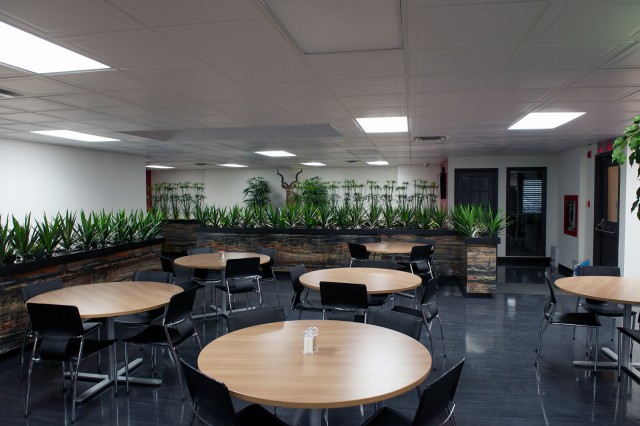
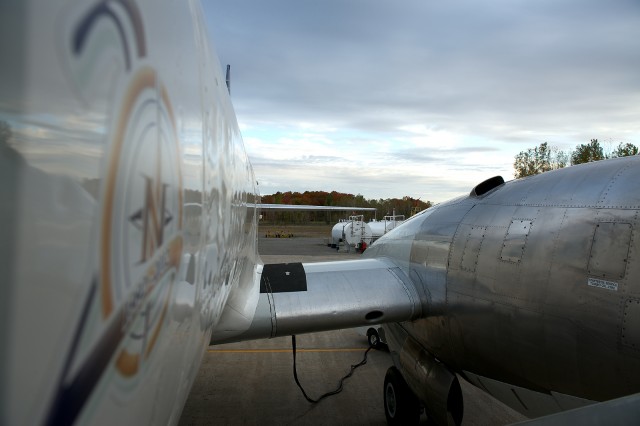
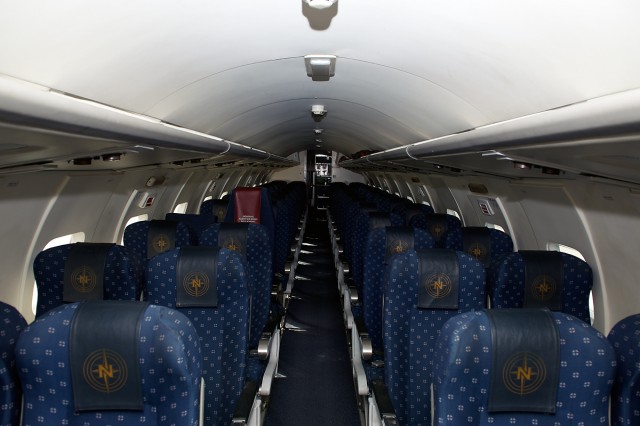
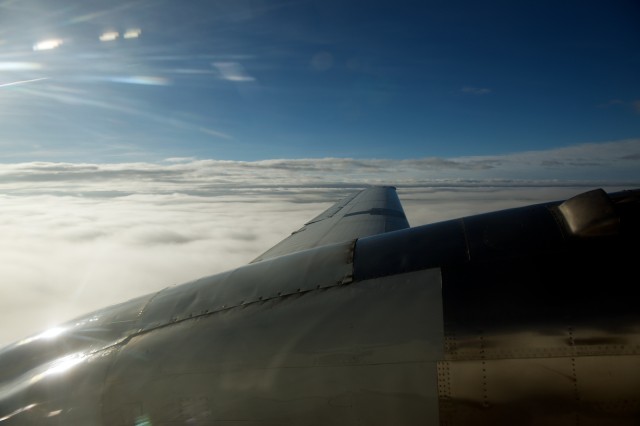
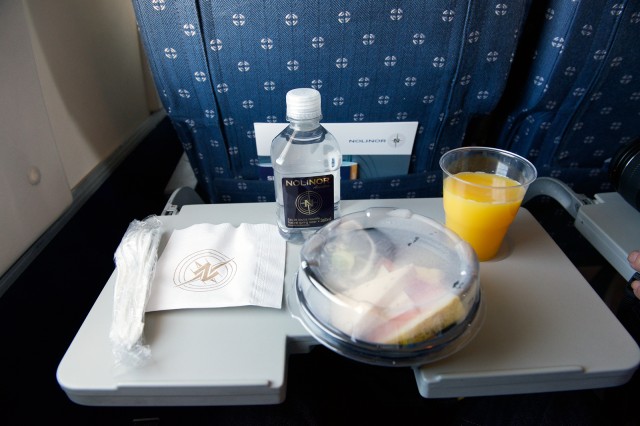
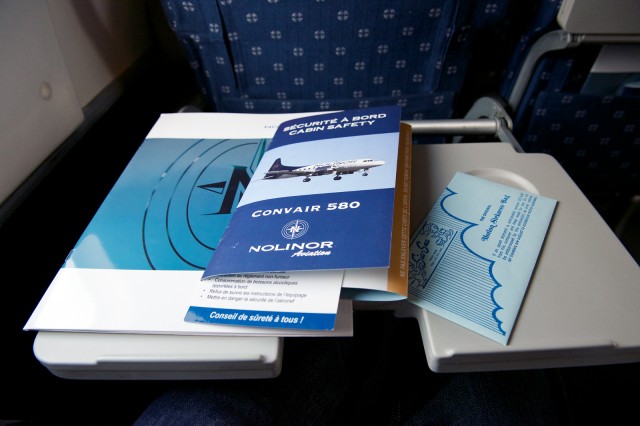
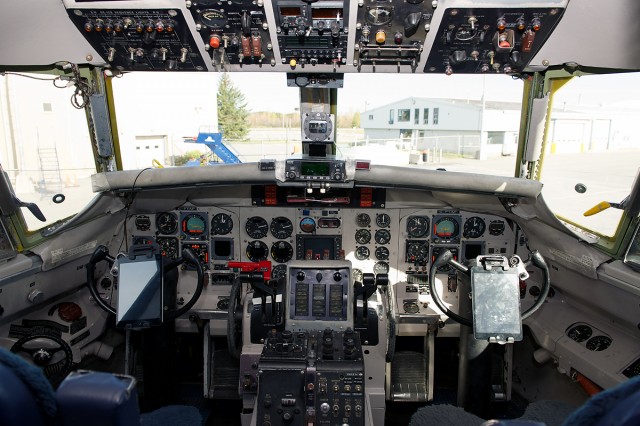
While I was reading the story,I was thinking the fact that the time of 50s and 60s,when convair used to soar the skies.The frequent passengers of that time.Great!
Allegheny Airlines used to have a daily Convair 580 that went Boston MA -Worcester MA – Keene NH – Boston. I flew it one morning for the fun of it, and as loud as it was, it was a lot of fun and very comfortable. Great memories!!
I also remember that the ticket agent hated booking it as it kept the same flight number, and the ticket machines of the time couldn’t handle the origin/destination being the same with one flight number. I miss the hand written ones!
I dig the updated “glass cockpit”.
Great story Bernie.
Neat story, always nice to read about the classics still flying.
If I had to guess about that extra door, it’s probably a leftover from when the plane flew cargo, and needed separation between the flight deck and the cargo area.
Great story – the interior looks great! Is it a Quick-Change type aircraft, which can be easily converted back to cargo?
I flew the CV-A340, A440 (CV-580) back in the late 70’s. and early 80’s. What a great workhorse!
Thinking that he’d find it interesting, I forwarded this link to an older friend of mine who is a walking aviation encyclopedia… I have no dog in this, but I’ll pass along his response:
> The Convair 440 was built to American Airlines” specifications to serve
> as a pressurized DC-3 replacement. It was equipped with Pratt & Whitney
> Double Wasp engines and three-bladed propellers, weather radar and a few
> other features that distinguished it from the original 240s.
The 440 was not built to AA’s specs. American never operated anything but the CV-240 except for two CV-580s for a short time under American Inter-Island livery. He got the engine type right (R-2800) but then blew it by saying that the 440’s props were somehow different than the 240 – they weren’t. Radar was not standard for any Convair until the 880. He forgot to mention the major difference between the 240 and the 440 – overall length.
> Upon boarding, I sat myself down to have a good engine/prop view and
> much to my dismay the window glass (now 57 years old) had begun to
> distort! It did not have a huge effect on any photography — but it was a
> tense few seconds.
I’d be willing to bet those pieces of plexiglass are not the same ones that Convair installed back in the day.
> To start a CV-580 efficiently, it”s wise to use a ground-start cart.
> Ours was connected and after it generated a high-amperage current, the
> number-two T56 engine began to spool up.
“Wise to use a ground-start cart”? How about mandatory? I have to admit that I have never heard of an electric-start Allison 501 – I’m not saying that there isn’t one, but all that I have seen used an air starter (either from an onboard APU or a truck-mounted AiResearch gas turbine).
> Those of you who have flown on any T56-engined aircraft will understand
> that they are not quiet (thankfully, for us AvGeeks). It”s completely
> different in sound than similarly-sized propliners of the era, for
> example the IL-18. It is somehow deeper and less shrill, something more
> akin to a chainsaw motor.
First off, I seriously doubt this frame has T56s – if this person is an “AvGeek” he really should use the proper terminology. CV-580s are normally equipped with a pair of Allison 501s (probably -D13s, but could be -D22s). Also, as an aside, the Il-18 was notorious for being one of the loudest passenger aircraft inside due to some unfortunate prop resonance problems, so I’d hope that there was a big difference in the perceived sound.
> Verdict: if someone walked up to me and offered me my own personal 580
> for a reasonable price, I”d buy it. Sure, it burns 535 gallons of fuel
> an hour and spare parts would mostly have to come from Convair C-131s
> but it”d be worth it. Engines would be easy to find and it does
> everything I”d ask of a small turbine. It is louder than some military
> firearms and comfortable to fly on.
Funny, Kelowna Flightcraft owns the type certificate for the 240/340/440 series (and variants) so I’d wager that spares are readily available and don’t have to be pulled from surplus C-131s, especially since Kelowna “manufactures” an extended CV-580 called the CV-5800. Also, “small turbine”? I’d hate to see what he considers a “big turbine”.
Just a note time air never operated TAP.
Time air or KI did operate 3 580s. TAO. KFW and ICA. The first of these being KFW obtained from Kelowna Flight craft in 1986 or 87.
KI also operated 2 640s PWY and PWS
Sorry that’s not correct. Time Air operated C-FTAP for a year or two until 1992 when it went to Canair Cargo. There are photos of it with Time Air. The Transport Canada aircraft register shows the last Time Air registration from August 1991 until June 1992 when it went to Canair Cargo, then to Nolinor in 1998. Other sources show its Time Air service starting in 1990 and it’s fleet number as 162.
The original article above is also incorrect where it refers to the aircraft as having been rolled off the assembly line in 1956 to start service with Time Air. Time Air didn’t exist until1966.
There are many sources with the history of this aircraft. It was delivered to Miami-based U.S. carrier National Airlines in 1956 before going to North Central Airlines who converted it from a 440 to 580 in 1968. After subsequent mergers it operated for Republic Airlines and then Northwest Airlines before going to Time Air.
The rzjets.net site will give you want appears to be a fairly accurate of C-FTAP’s history. Enter the registration in the first search box.
I flew many, many times on Frontier 240/340/440’s from DEN to OMA, complete with four stops in Nebraska there between!! I chose FN over UA non-stops just for the fun of it!! (WOW, I am really old!)
I FLEW THE CONVAIR 440 , Variant C131 B . N7814B. Flew it in Mexico for 14 Yrs. Flying to Fishing Villages. Hauling LIVE LOBSTER. 8000 lbs. And it actually was the last Propliner Operated in Mexico.
The last flight was on Sep 2009. Mexican Registered XA-SQG.
I was a Flight Engineer and structural mechanic on Navy C-131 H’s (VIPed out and long range) 580’s late 70’s early 80’s. I LOVED that aircraft, beautiful bird in flight, cursed the fuel leaks it tended to have at times. Ours once belonged to the 89th squadron of the Air Force. No sat phones connected but still pretty luxurious for a Navy transport.
They would JUMP into the air if called to do so, V2 climbs were fun. A bit cramped in the collapsible jump seat but once cruising I could often go back aft and snooze the night before fun off. 15 degree flap TO settings were standard unless at places like Denver. 0 flaps and a need for speed was the tradeoff.
We lost an aircraft and crew at Dothan Al in 1985, no fault of bird or crew. (RIP fellows) Civilian rework facility but that’s another story.
In about 2016 I chanced on a 580 on the apron at Hamilton, NZ. It was white, had no fleet livery, only its ZH identification. I had never seen one before, and I want to fly in one. I travel to NZ annually and to Canada sometimes. I live in the UK.Where can I travel in one without going to the Chatham Islands.
Unfortunately the old Convair fleet are getting like hens teeth. Canada is using a handful as water bombers and you might find a few in Alaska. Soon they’re only going to be museum pieces.
Does anyone operate CV-580’s nowadays?